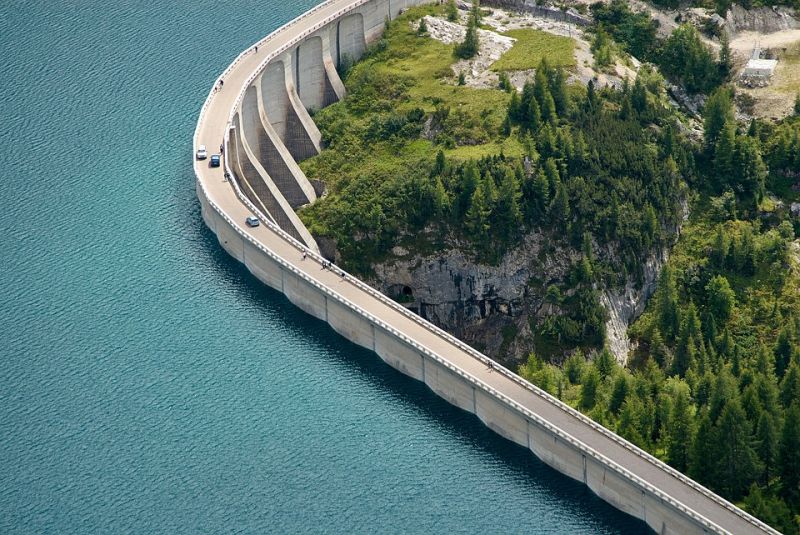New Study Calls for Careful Consideration When Planning Dams and Reservoirs
Published on by Water Network Research, Official research team of The Water Network in Academic
Drought scientists argue that while many dams and reservoirs are built, or expanded to alleviate droughts and water shortages, they can paradoxically contribute to making them worse.

Representative Image Source: Pixabay, labeled for reuse
A team of ten drought scientists, including the University of Birmingham, argues that while many dams and reservoirs are built, or expanded to alleviate droughts and water shortages, they can paradoxically contribute to make them worse. This perspective paper is published in the journal Nature Sustainability.
Building dams and reservoirs is one of the most common approaches to cope with drought and water shortage. The aim is straightforward: reservoirs can store water during wet periods, and then release it during dry periods. As such, they can stabilize water availability, thereby satisfying water demand and alleviating water shortage. However, the paper shows that increasing reservoir storage capacity can also lead to unintended effects in the long term, and, paradoxically, worsen water shortage.
The authors argue that there are two counterintuitive phenomena that should be considered when expanding or planning reservoirs: the supply-demand cycle and the reservoir effect.
The supply-demand cycle describes cases where increasing water supply leads to higher water demand, which can quickly offset the initial benefits of reservoirs. These cycles can be seen as a rebound effect, also known in environmental economics as Jevon’s paradox: as more water is available, water consumption tends to increase. This can result in a vicious cycle: a new water shortage can be addressed by further expansion of reservoir storage to increase (again) water availability, which enables more water consumption, until the next shortage. As such, the supply-demand cycle can trigger an accelerating spiral towards unsustainable exploitation of water resources and environmental degradation.
The reservoir effect describes cases where over-reliance on reservoirs increases the potential damage caused by drought and water shortage. The expansion of reservoirs often reduces incentives for preparedness and adaptive actions, increasing the negative impacts of water shortage. Moreover, extended periods of abundant water supply supported by reservoirs can generate higher dependence on water resources, which in turn increases social vulnerability and economic damage when water shortage eventually occurs.
The study led by Dr Giuliano Di Baldassarre from the University of Uppsala also provides policy implications. He said:
‘Attempts to increase water supply to cope with growing water demand, which is fueled by the increase in supply, is unsustainable. Hence, we suggest less reliance on large water infrastructure, such as dams and reservoirs, and more efforts in water conservation measures - in other words, coping with drought and water shortage by reducing water consumption, rather than fueling consumption by increasing water supply. While many water experts would agree with this general recommendation, numerous dams and reservoirs are still being built or proposed in many places around the world.’
Dr Anne Van Loon, from the University of Birmingham’s School of Geography, Earth and Environmental Sciences and co-author on the paper, said:
‘The notion that "we must increase water availability to satisfy a growing water demand" remains pervasive because there are major knowledge gaps in the study of the dynamics generated by the interplay of water, society and infrastructure. We propose a specific research agenda to unravel the long-term effects, including the unintended consequences of reservoirs, and other types of water infrastructure, on the distribution of water availability and demand.’
Dr Sally Rangecroft, from the University of Birmingham’s School of Geography, Earth and Environmental Sciences, said:
‘In the paper we show a number of cases of the proposed supply-demand cycle and reservoir effect happening around the world, from the Maja’s to Las Vegas and from Athens in Greece to Melbourne, Australia. These examples reveal that a social perspective of dealing with water shortage is crucial and research on feedbacks between water and society is paramount. At the University of Birmingham, we have an ongoing collaboration between human and physical geographers developing different approaches to solve the water problems that societies are facing and proposing sustainable solutions for the future.”
Reference:
Di Baldassarre, G., Wanders, N., AghaKouchak, A., Kuil, L., Rangecroft, S., Veldkamp, T.I.E., Garcia, M., van Oel, P.R., Breinl, K., and Van Loon A.F. "Water shortages worsened by reservoir effects", Nature Sustainability, November 208, DOI: https://doi.org/10.1038/s41893-018-0159-0
Source: University of Birmingham
Media
Taxonomy
- Water Scarcity
- Water Supply
- Hydrology
- Ecohydrology
- Drought
- Water Supply
- Water Supply & Drainage
- Water Supply Design
- Rural Area Water Supply
- Urban Water Supply
- Infrastructure
- Dams
- Reservoir
- Integrated Infrastructure
- Urban Water Infrastructure
- Infrastructure Management
- Hydrology
- Hydrological Automation
- Hydrologist
- Flood damage
- Hydrology Cycle
- Experimental Hydrology Models
- Infrastructure Providers
- green infrastructure